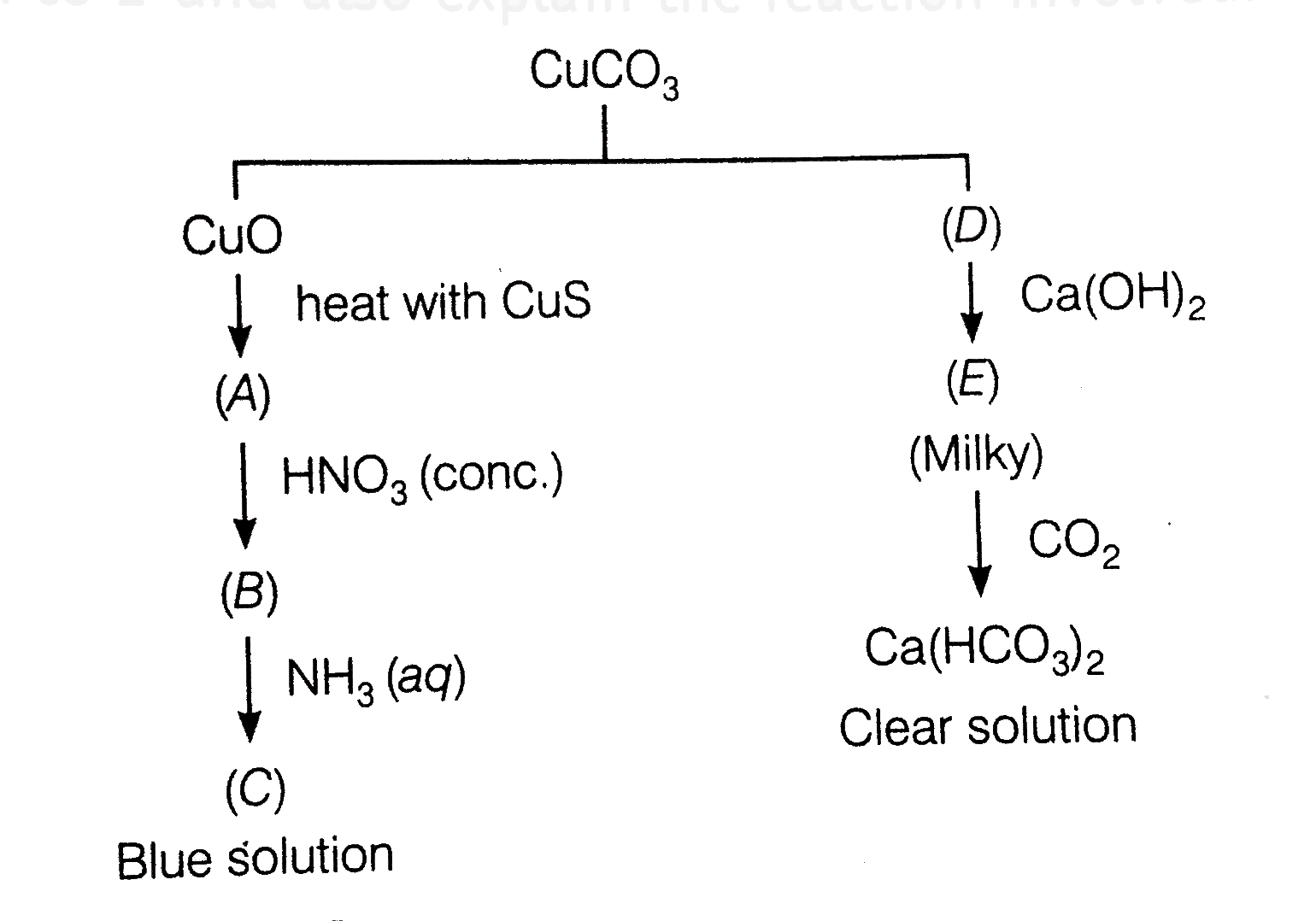Identify A to E and explain the reactions involved.

The compounds A to E are
A=CuB=Cu(NO3)2C=[Cu(NH3)4]2+D=CO2E=CaCO3F=Cu2[Fe(CN)6]G=Ca(HCO3)2
The reactions are explained as under :
CuCO3→CuO+CO2
2CuO+CuS→3Cu(A)+SO2
Cu+4HNO3Conc.−−→Cu(NO3)2+2NO+2H2O(B)
Cu2+(B)+NH3→[Cu(NH3)4]2+
Ca(OH)2+CO2(D)→C(E)aCO(3)+H2O
CaCO3+H2O+CO2→Ca(HCO3)2
Topper's Solved these Questions
- BOOK - U-LIKE SERIESCHAPTER - THE D-AND F-BLOCK ELEMENTS EXERCISE - LONG ANSWER QUESTIONS-II (5 marks each)21videos
THE D-AND F-BLOCK ELEMENTS
- BOOK - U-LIKE SERIESCHAPTER - THE D-AND F-BLOCK ELEMENTS EXERCISE - SELF ASSESSMENT TEST (SECTION A ) MULTIPLE CHOICE QUESTIONS (CHOOSE THE CORRECT OPTION)7videos
THE D-AND F-BLOCK ELEMENTS
- BOOK - U-LIKE SERIESCHAPTER - THE D-AND F-BLOCK ELEMENTS EXERCISE - SHORT ANSWER QUESTIONS (2 marks each)42videos
THE D-AND F-BLOCK ELEMENTS
- BOOK - U-LIKE SERIESCHAPTER - SURFACE CHEMISTRYEXERCISE - SELF ASSESSMENT TEST ( SECTION A)7videos
SURFACE CHEMISTRY
- BOOK - U-LIKE SERIESCHAPTER - THE P-BLOCK ELEMENTS EXERCISE - SELF ASSESSMENT TEST ( SECTION A)7videos
THE P-BLOCK ELEMENTS
Similar Questions
0.396 gm of a bromoderivative of a hydrocarbon (A) when vapourized occupied 67.2 ml at NTP. On reaction with aqueous NaOH, (A) gives (B). (B) when passed over alumina at 250∘C gives a neutral compound (C ), while at 350∘C it gives a hydrocarbon (D): (D) when heated with HBr gives an isomer of (A). When (D) is treat with conc. H2SO4 and the product is diluted with water and distilled, (E) is obtained. Identify (A) to (E) and explain the reaction involved.
View SolutionIdentify A to E and also explain the reaction involved.
 View Solution
View SolutionIdentify A to E and also explain the reaction involved.
 View Solution
View SolutionH2C2O4Δ−−→ gas (A)+gas(B)+liquid(C) oxalic acid Gas (A) burns with blue flame and is oxidised to gas (B). Gas (B) turns lime water milky
Gas (A)+Cl2→(D)NH3.Δ−−−−→(E)NH3.ΔB
Identify (A) to (E) and explain reactions involved.View SolutionH2C2O4Δ−−→ gas (A)+gas(B)+liquid(C) oxalic acid Gas (A) burns with blue flame and is oxidised to gas (B). Gas (B) turns lime water milky
Gas (A)+Cl2→(D)NH3.Δ−−−−→(E)NH3.ΔB
Identify (A) to (E) and explain reactions involved.View Solution0.36 g of a bromoderivative of a hydrocarbon (A) when vaporized occupied 65.2 mL at NTP. (A) on reaction with aqueous NaOH gave (B). (B) when passed over alumina at 250∘C, gives a neutral compound (C) while at 350∘C, it gives a hydrocarbon (D). (D) when treated with HBr gave an isomer of(A). When (D) is treated with conc. H2SO4 and the product is diluted with water and distilled, (E) is obtained. Identify from (A) to (E) and explain the reactions involved.
View Solution0.36 g of a bromoderivative of a hydrocarbon (A) when vaporized occupied 65.2 mL at NTP. (A) on reaction with aqueous NaOH gave (B). (B) when passed over alumina at 250∘C, gives a neutral compound (C) while at 350∘C, it gives a hydrocarbon (D). (D) when treated with HBr gave an isomer of(A). When (D) is treated with conc. H2SO4 and the product is diluted with water and distilled, (E) is obtained. Identify from (A) to (E) and explain the reactions involved.
View Solution0.36 g of a bromoderivative of a hydrocarbon (A) when vaporized occupied 65.2 mL at NTP. (A) on reaction with aqueous NaOH gave (B). (B) when passed over alumina at 250∘C, gives a neutral compound (C) while at 350∘C, it gives a hydrocarbon (D). (D) when treated with HBr gave an isomer of(A). When (D) is treated with conc. H2SO4 and the product is diluted with water and distilled, (E) is obtained. Identify from (A) to (E) and explain the reactions involved.
View SolutionA pale yellow substance (A) when heated with conc.HNO3 evolves a brown coloured gas (B). The substance (A) also dissolves in sodium sulphite solution on heating. A clear solution (c) is formed which on acidification gives a turbid solution and a pungent smelled gas (D) which is formed by the substance (A) in air. The solution (c) decolourises iodine solution, Identify (A) to (D).
View SolutionWhen a mixture of ammonium chloride and potassium dichromate was heated, a stable colourless gass (A) was evolved which did not support combustion, but magnesium continued to burn in it. The gas (A) reacted with calcium carbide in an electric furnace a solid (B) which was slowly hydrolysed by water forming an insoluble substance (C) and the solution of a substance (D) which turned Nessler's reagent brown. Identify substances (A) to (E) and explain all the reactions involved.
View Solution

